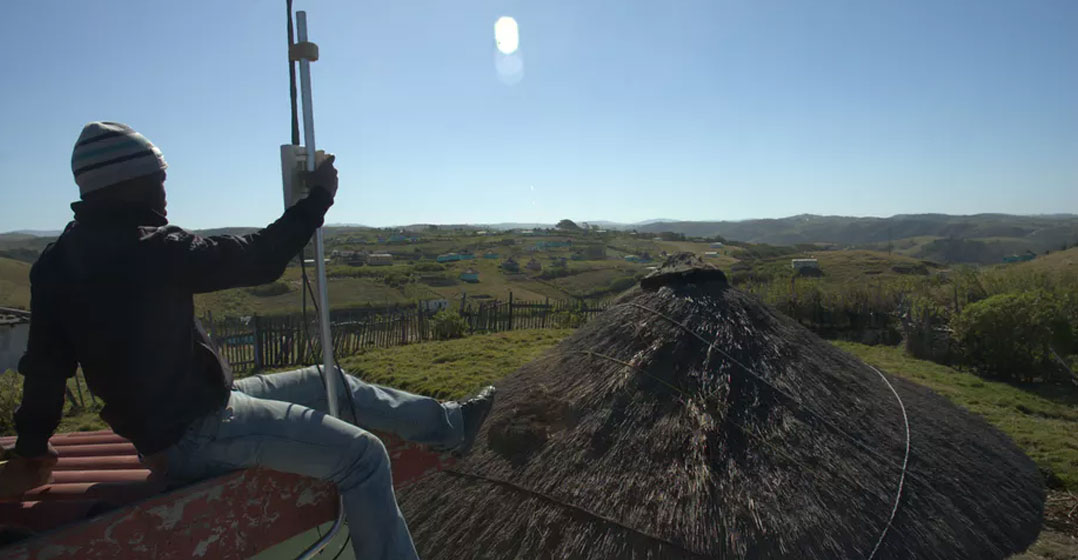
Mankosi is a remote rural community in South Africa’s Eastern Cape province. It is home to almost 6 000 people. The nearest city is Mthatha, about 60km away, as a bird flies.
Most homes are not connected to the electricity grid; residents charge their cellphones at a local shop or shebeen, for which they must pay. Both data and airtime for those phones also cost a lot: a survey shows that people spend up to 22% of their income on telecommunications. This is money that could be spent on food, education, transport and other needs.
They’re not alone. South Africa has some of the highest mobile voice and data costs in the world.
Yet, things are changing in Mankosi. A research team at the University of the Western Cape has worked with residents to develop a solar powered wireless community network.
The Zenzeleni Networks project — Zenzeleni means “do it yourself” in isiXhosa, the Eastern Cape’s most prevalent language — is, as far as we’re aware, the South Africa’s first and only Internet service provider that’s owned and run by a rural cooperative. Just like any ISP, Zenzeleni installs and maintains telecoms infrastructure and also sells services like voice and data.
Yet what’s special about the project is that it involves a registered not-for-profit company that works with cooperatives in the community to deliver affordable voice and data services. Crucially, the project also keeps money in communities like Mankosi, often beset by high rates of unemployment.
The community networks model has proven successful elsewhere in the world: the largest is in Spain — the Guifi.net project. Others that have been developed successfully include projects in Zambia and Mexico.
Local leaders
The Mankosi project was launched in 2012 and legally registered in 2014. I have done research on ICT for development in the Mankosi area since 2003. Since then, colleagues and postgraduate students, have also worked, even lived, in the area for extensive periods of time.
To establish the Zenzeleni network, we approached local leaders to help get the community on board and we provided help and mentorship. Ultimately, the residents run the project themselves.
With the local authority’s permission, a cooperative comprising 10 local and respected people was formed. This group designed the network layout, and built and installed a dozen solar-powered mesh network nodes or stations. These are mounted on and inside houses around Mankosi. These are organised in what we call a mesh network and Wi-Fi stations cover an area of 30 square kilometres.
Zenzeleni constitutes a full-fledged ISP, equipped with an Internet and voice-over-Internet protocol gateway, community managers and a billing system in isiXhosa.
Communications regulator Icasa, which grants licences to ISPs and collects fees where necessary, granted Zenzeleni a licence exemption; so it costs Zenzeleni nothing in fees to operate infrastructure and sell services. The community only has to pay for the backhaul Internet connectivity, which they can get at wholesale prices from companies like Easttel and Openserve, and for educational use from Tenet.
Any device — even a low- to midrange smartphone — that’s Wi-Fi-enabled can access the network. There’s a dedicated wireless connection to “point of presence” fibre in Mthatha.
Zenzeleni’s voice calls and data costs are much cheaper than what’s offered by the big mobile operators. For example, voice calls can cost 20c/minute rather than the standard R1.50 or more, while data costs can be between 20 and 40 times cheaper.
The solar-powered stations also charge cellphone batteries for R3.50 instead of the R5 usually charged by spaza shops or shebeens. Those shops tend to be some distance from the village, so people save time as well as money.
A true community project
Community is at the heart of Zenzeleni’s model. All revenues stay in the community: each cooperative has a bank account, and all residents get together to decide what to do with the money that’s been paid for Zenzeleni services.
For example, the Mankosi cooperative has provided micro-loans to residents for starting small businesses.
No one is currently earning a salary from the community network. But when usage grows, as we expect it will do with super cheap data, revenues are likely to grow so much that the cooperative will want to install more nodes and hire people to actively maintain them making the network more resilient. Since March 2014, the project has earned around R33 600.
On the surface, it may appear that Zenzeleni cannibalises the revenues of big telecoms companies like Telkom. We believe the opposite is true. Firstly, Zenzeleni purchases backhaul Internet connectivity from areas like Mankosi that Telkom and others have failed to connect — so it’s operating in entirely new areas that have been ignored because they’re considered too remote to generate good revenue.
Secondly, all telecoms companies earn interconnect fees. Calls to mobile and landline numbers across South Africa incur these fees, which are charged when calling from one network to another. This is also true for Zenzeleni, so that’s extra money in the bank for those companies.
Lastly, and most importantly, most of the money generated by this project stays in Mankosi. This is perhaps the most crucial aspect of the Zenzeleni model, and one we believe will foster economic growth which will benefit people living in and around the village, and enable them to purchase telecommunications, and other goods and services, they currently cannot afford.
Zenzeleni Networks’ next goal is to build critical mass to support between 20 and 30 communities surrounding Mankosi. When this happens, about 300 000 people will be able to sustainably connect themselves — and their schools, clinics, hospitals and homes — to cheaper voice, data and phone battery charging. This puts telecoms into their own hands, by themselves.![]()
- Written by Bill Tucker, associate professor of computer science, University of the Western Cape
- This article was originally published on The Conversation




